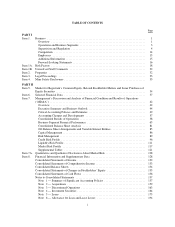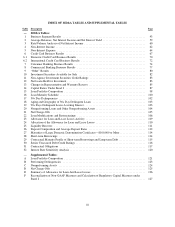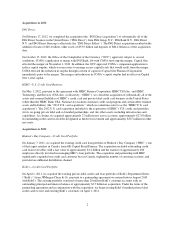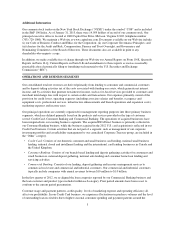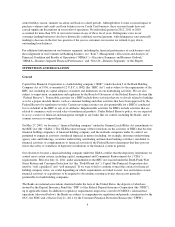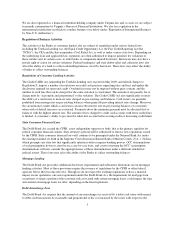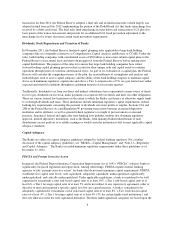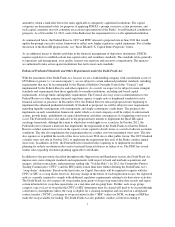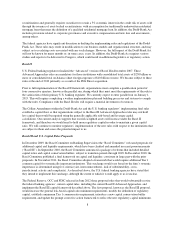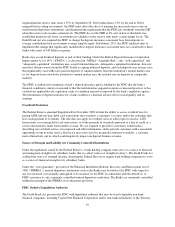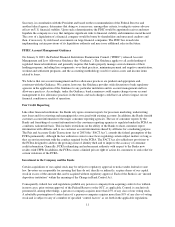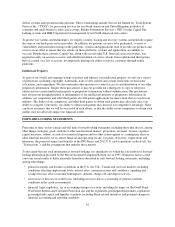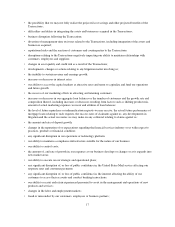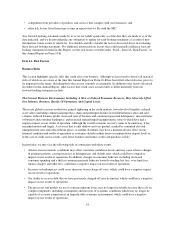Capital One 2012 Annual Report Download - page 27
Download and view the complete annual report
Please find page 27 of the 2012 Capital One annual report below. You can navigate through the pages in the report by either clicking on the pages listed below, or by using the keyword search tool below to find specific information within the annual report.securitizations and generally requires securitizers to retain a 5% economic interest in the credit risk of assets sold
through the issuance of asset-backed securitizations, with an exemption for traditionally underwritten residential
mortgage loans that meet the definition of a qualified residential mortgage loan. In addition, the Dodd-Frank Act
includes provisions related to corporate governance and executive compensation and new fees and assessments,
among others.
The federal agencies have significant discretion in drafting the implementing rules and regulations of the Dodd-
Frank Act. These rules may result in modifications to our business models and organizational structure, and may
subject us to escalating costs associated with any such changes. However, the full impact of the Dodd-Frank Act
will not be known for many months or, in some cases, years. In addition, the Dodd-Frank Act requires various
studies and reports to be delivered to Congress, which could result in additional legislative or regulatory action.
Basel II
U.S. Federal banking regulators finalized the “Advanced” version of Basel II in December 2007. These
Advanced Approaches rules are mandatory for those institutions with consolidated total assets of $250 billion or
more or consolidated total on-balance-sheet foreign exposure of $10 billion or more. We became subject to these
rules at the end of 2012 primarily as a result of the ING Direct acquisition.
Prior to full implementation of the Basel II framework, organizations must complete a qualification period of
four consecutive quarters, known as the parallel run, during which they must meet the requirements of the rule to
the satisfaction of their primary U.S. banking regulator. We currently expect to enter parallel run on January 1,
2015. This will require completing a written implementation plan and building processes and systems to comply
with the rules. Compliance with the Basel II rules will require a material investment of resources.
The Collins Amendment within the Dodd-Frank Act and the U.S. banking regulators’ implementing final rules
establish a capital floor so that organizations subject to the Basel II Advanced Approaches rules may not hold
less capital than would be required using the generally applicable risk-based and leverage capital
calculations. Our current analysis suggests that our risk-weighted assets will increase under the Basel II
framework, and therefore we would need to hold more regulatory capital in order to maintain a given capital
ratio. We will continue to monitor regulators’ implementation of the new rules with respect to the institutions that
are subject to them and assess the potential impact to us.
Basel III and U.S. Capital Rules Proposals
In December 2009, the Basel Committee on Banking Supervision (the “Basel Committee”) released proposals for
additional capital and liquidity requirements, which have been clarified and amended in recent pronouncements
(“Basel III”). In September 2010, the Basel Committee announced a package of reforms that included detailed
capital ratios and capital conservation buffers, subject to transition periods through 2018. In December 2010, the
Basel Committee published a final framework on capital and liquidity, consistent in large part with the prior
proposals. In November 2011, the Basel Committee adopted a framework that would require additional Tier 1
common capital for systemically important institutions. This surcharge would vary based on the firm’s systemic
importance as determined using five criteria (size, interconnectedness, lack of substitutability, cross-
jurisdictional activity and complexity). As described above, the U.S. federal banking agencies have stated that
they intend to implement this surcharge, although the extent to which it would apply to us is unclear.
The Federal Reserve, OCC and FDIC released in June 2012 three proposed rules that would substantially revise
the federal banking agencies’ current capital rules, including the current Basel II Advanced Approaches, and
implement the Basel III capital framework described above. The first proposal, known as the Basel III proposal,
would increase the general risk-based capital ratio minimum requirements, modify the definition of regulatory
capital, establish a minimum Tier 1 common ratio requirement, introduce a new capital conservation buffer
requirement, and update the prompt corrective action framework to reflect the new regulatory capital minimums.
8


